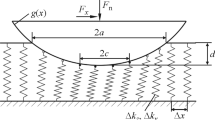Abstract
A rigid indentor travels with a constant speed over the surface of an isotropic thermoelastic half-space. Friction exists between the indentor and half-space, and the latter is initially in equilibrium at a uniform temperature under a uniform normal pre-stress. This pre-stress, below but near yield, is assumed to produce deformations that dominate the additional deformations due to indentation. Thus, the process is treated as one of small deformations superposed upon (relatively) large. The governing equations for the superposed deformation are those of nonisotropic coupled thermoelasticity.
A steady-state two-dimensional study uses robust asymptotic analytical solutions to reduce the associated mixed boundary value problem to a classical singular integral equation which can be solved analytically.
The solutions show that the pre-stress-induced de facto nonisotropy alters the values of the rotational and dilatational wave and Rayleigh speeds in the half-space and, in the case of a compressive pre-stress, generates a second, lower, critical speed. In addition, pre-stress generates noncritical sliding speeds at which the friction-dependent integral equation eigenvalue changes sign.
For purposes of illustration, expressions for the half-space surface temperature change and its average over the contact zone, the equations necessary to determine contact zone size and location, the resultant moment on the indentor, and the maximum compressive stress on the contact zone are presented for a parabolic indentor.
Similar content being viewed by others
References
J.R. Barber, The influence of thermal expansion on the friction and wear process. Wear 10(1967) 155-159.
R.G. Bayer, Mechanical Wear Prediction and Prevention. Marcel Dekker, New York (1994).
P.J. Blau, Friction Science and Technology. Marcel Dekker, New York (1996).
L.M. Brock, Some analytical results for heating due to irregular sliding contact of thermoelastic solids. Indian J. Pure and Appl. Math. 27(12) (1996) 1257-1278.
R. Hill, The Mathematical Theory of Plasticity. Oxford University Press (1950).
A.E. Green and W. Zerna, Theoretical Elasticity. Oxford University Press (1954).
A.E. Green and J.E. Adkins, Large Elastic Deformations. Oxford University Press (1960).
J.D. Achenbach, Wave Propagation in Elastic Solids. North-Holland/American Elsevier, Amsterdam (1973).
I.S. Sokolnikoff, Mathematical Theory of Elasticity, McGraw-Hill, New York (1956).
H.E. Boyer and T.L. Gall, Metals Handbook. American Society for Metals (1985).
P.C. Chadwick, Thermoelasticity: The dynamical theory. In: I.N. Sneddon and P. Hill (eds), Progress in Solid Mechanics, Vol. I. North-Holland, Amsterdam (1960).
B.A. Boley and J.H. Weiner, Theory of Thermal Stresses. Krieger, Malabar, FL (1985).
L.M. Brock, Transient thermal effects in edge dislocation motion near a crack edge. Int. J. Solids Struct. 29(18) (1992) 2217-2234.
B. van der Pol and H. Bremmer, Operational Calculus Based on the Two-Sided Laplace Integral. Cambridge University Press (1950).
M. Abramowitz and I.A. Stegun, Handbook of Mathematical Functions. Dover, New York (1970).
I.S. Gradshteyn and I.M. Ryzhik, Table of Integrals, Series and Products. Academic Press, New York (1980).
E. Hille, Analytic Function Theory. Vol. 1. Blaisdell, Waltham (MA) (1959).
L.M. Brock, Transient three-dimensional Rayleigh and Stoneley signal effects in thermoelastic solids. Int. J. Solids Struct. 34(12) (1997) 1463-1478.
L.M. Brock, Analytical results for roots of two irrational functions in elastic wave propagation. J. Australian Math. Soc. B 40(1998) 72-79.
P.A. Morse and H. Feshbach, Methods of Theoretical Physics, Part I. McGraw-Hill, New York (1953).
L.M. Brock, Sliding and indentation by a rigid half-wedge with friction and displacement coupling effects. Int. J. Eng. Sci. 19(1) (1981) 33-40.
H.G. Georgiadis and J.R. Barber, On the super-Rayleigh/subseismic elastodynamic problem. J. Elast. 31 (1993) 141-161.
G.F. Carrier and C.E. Pearson, Partial Differential Equations. Academic Press, New York (1988).
N.I. Muskhelishvili, Some Basic Problems of the Mathematical Theory of Elasticity(J.R.M. Radok, transl.). Noordhoff, Leyden (1975).
F. Erdogan, Boundary value problems in mechanics. In: S. Nemat-Nasser (ed.), Mechanics Today, Vol. 4. Pergamon, New York (1976).
Author information
Authors and Affiliations
Rights and permissions
About this article
Cite this article
Brock, L. Rapid Sliding Indentation with Friction of a Pre-Stressed Thermoelastic Material. Journal of Elasticity 53, 161–188 (1998). https://doi.org/10.1023/A:1007547915638
Issue Date:
DOI: https://doi.org/10.1023/A:1007547915638




